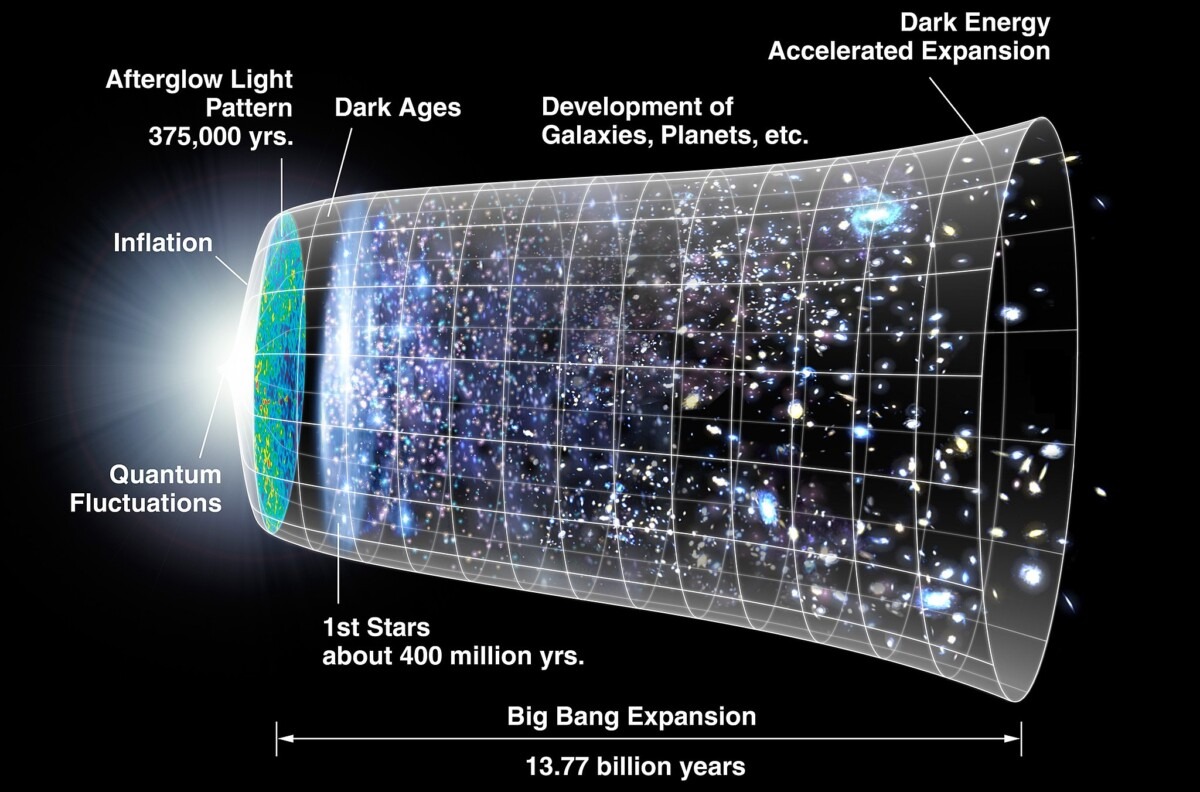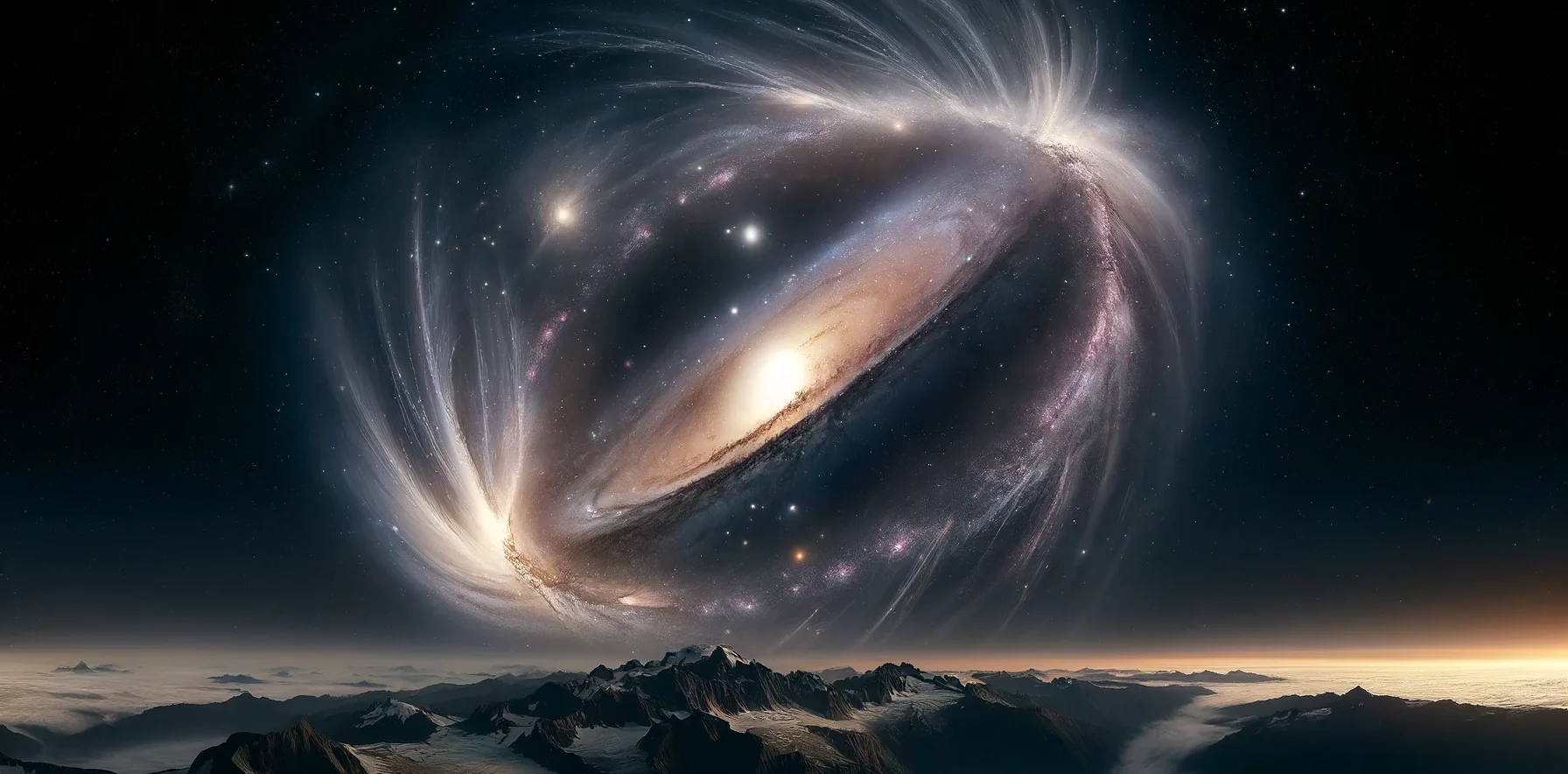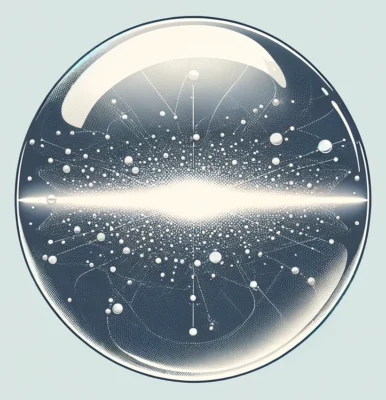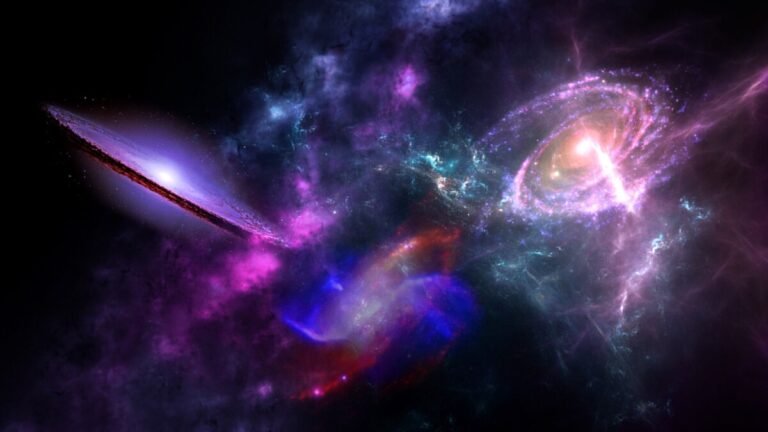This article describes our expanding universe. Its size, the CMB, and current theories. To be clear, the ideas in this article are less speculative. Meaning, experts in the field have high faith that they are true. To ensure clarity and enhance understanding, it’s crucial to distinguish between well-supported scientific concepts and those that remain speculative.
It’s important to separate out our good ideas, which we believe are true, from our speculative guesses. Mixing them causes confusion. One such confusion centers around our guesses about the end of the universe. For an overview of those ideas, read my article, The End of the Universe Explained. If you are familiar with my Idea of Ideas, that article explores our irrational ideas, our speculative ideas.
For a visual insight into our expanding universe, check out The Big Bang Timeline. It includes speculation on the singularity and the first second of existence. For now, though, let’s stick to solid ground and explore a few rational and empirical ideas. Specifically, let’s explore the rational ideas about the empirical observations of our expanding universe.

Current estimates place the universe’s expanse at a staggering 93 billion light-years across, and it’s rapidly expanding. This “edge” of the universe, while detectable, marks the limits of our current observational capabilities. We perceive this boundary in the microwave band of light. Predicted in the 1940s, the existence of this cosmic frontier was confirmed through microwave observations in 1965, leading to the identification of what we now know as the Cosmic Microwave Background, or CMB.
This background glow from the CMB represents the farthest point in space detected by humans. The light from the CMB is believed to have embarked on its journey to us just 380,000 years after the Big Bang. Based on redshift measurements, we observe the distance to the CMB uniformly in every direction. This observation has big and profound implications for our current understanding of the universe.
The discovery of the CMB was a pivotal moment in cosmology, lending strong support to the Big Bang theory and contributing to the development of the Standard Model of particle physics. The Big Bang is supported by the theory of general relativity, observations of the CMB, and supported by a wide range of scientific observations and disciplines. So far nothing contradicts it.

When we “look” at the CMB, we’re essentially peering back into the universe’s infancy, just after the Big Bang. This singular event is credited with creating all matter that populates the universe today. Meaning, the particles that make up matter are never actually destroyed, and nothing creates new ones. That’s what Einstein’s famous E=mc2 equation clarified. Matter is energy, and energy is matter. You can transform them, but never destroy, nor create them.
The foundation for relativity is Galileo’s Relativity Principle, which states that the laws of physics are the same for everyone, regardless of how they’re moving. Special Relativity, born in 1905, explains how space, time, mass, and energy are interconnected. It showed that as objects approach the speed of light, time slows down, lengths contract, and mass increases. Finally, General Relativity, introduced in 1915, explains gravity not as a force, but as a warping of spacetime caused by massive objects. This warping tells us how objects move in the universe.

Weekly Wisdom Builder
Got 4 minutes a week?
A new 4-minute thought-provoking session lands here every Sunday at 3PM, emailed on Mondays, and shared throughout the week.
Exactly what the world needs RIGHT NOW!
To date, we’ve identified 17 fundamental particles and four forces. While we’re pretty confident there are only four forces in the universe, we have speculative ideas that their might be more particles. For example, one central speculative idea is a particle called “graviton” which would represent gravity. If we find it, its discovery could lead to a unified model of the universe reconciling Einstein’s theories with quantum mechanics. Remarkably, the vast complexity of the universe can be distilled into these 17 or 18 particles and four forces.
The image of the early universe that we see in the CMB reveals a time shrouded in darkness. During this era, the 17 known particles first started to combine to form the universe’s first atoms. Electrons, protons, and neutrons came together to create neutral hydrogen atoms, a process that allowed photons—or light—to traverse the cosmos freely. That is the glow we see in the CMB. Soon after this, well, cosmically soonish, gravity played its part and brought these atoms together, forming the first stars and galaxies. This “let-there-be-light” event occurred about 100 million years after the Big Bang.
Over the next 13.7 billion years, the very fabric of the universe expanded rapidly. The fabric of the universe itself is stretching, meaning that galaxies are moving away from each other, not through space, but as part of the expansion of space. This expansion isn’t just happening in specific locations; it’s a universal phenomenon where everything is receding from everything. While only 13.7 billion years have passed since the first stars were forged, the particles for the farthest galaxies are more than 30 billion light-years away. They are farther away than time should allow because everything is stretching.
Let’s use the GN-z11 galaxy to illustrate. It’s 32 billion light years from us. The light we see from it was created about 400 million years after the Big Bang. Meanwhile, the GN-z11 galaxy kept traveling in space. If the Lambda constant for the expansion of the universe is correct, GN-z11 is now 32 billion light years away. And, that distance is only about halfway to the theorized current size of the known universe. The verified model of the universe predicts it extends out about 46.5 billion light-years in every direction which means its full size, its diameter, is 93 billion light-years currently, and expanding.
This also means the universe had to have expanded on average slightly faster than the speed of light; otherwise, the distance would be less than 13.4 billion light years, but it’s not. The GN-z11 galaxy is currently 32 billion light years away. That means the universe expanded at a rate of something like 1.39 times the speed of light, on average. That’s about the average speed that’s required for the universe’s expansion to push GN-z11 out 32 billion light years from us. Well, in truth, both are part of the expansion, and both are expanding from each other. One more clarification, we currently think the expansion of the universe is picking up, so that 1.39 times the speed of light is an average estimate of what was needed to account for the 32 billion light-year distance estimated between GN-z11 and Earth.
I guess the old saying:
“Nothing can travel faster than light,”
needs to be updated to:
“Nothing but the universe itself can travel faster than light.”

This cosmic expansion was first observed by Edwin Hubble in the late 1920s. It underlies the notion that the universe began from a singularly dense point, and that point has been expanding ever since. The implications of this expansion are profound, influencing our understanding of the universe’s past, its future, and the ultimate fate of all its contents.
Current estimates, derived from redshift measurements, suggest the Cosmic Microwave Background (CMB) is about 46.5 billion light-years away from us in every direction. That’s where the get the size of the universe, the 93 billion light-year diameter of the “known” universe.
This vast scale is beyond human comprehension, but we can try to put it into perspective. Let’s talk about a journey to Proxima Centauri, our nearest stellar neighbor at a mere 4.24 light-years away. To frame how far that is, let’s compare it to our fastest planes. If one were to journey from London to New York aboard the Concorde, one of the fastest airplanes ever built, capable of making the trip in under three hours, it would still take over two million years to reach Proxima Centauri.
Next, let’s consider the Parker Solar Probe, the fastest man-made object to date, achieving speeds of up to 430,000 miles per hour in its orbit around the Sun. This unprecedented velocity results from a combination of gravity assists from Venus and the powerful gravitational pull of the Sun, allowing unprecedented study of solar phenomena. Despite its record-breaking speed, the probe would require more than 6,000 years to reach Proxima Centauri, our nearest stellar neighbor. This fact highlights the vastness of the cosmos. The observable universe, spanning about 93 billion light-years in diameter, presents a scale so immense that it challenges our comprehension.
What implications does this have? The enormity of the universe and the intricacies of distant galaxies assume a predominantly philosophical dimension. We are left to theorize, ponder, and test scientific ideas about their nature, yet the true scope remains largely beyond our reach.
This brings us to a philosophical crossroads. Observing the universe, we find ourselves able to gaze the same distance in all directions. Does this place us at the universe’s heart? It might appear to echo ancient beliefs that positioned Earth at the center of all things. However, this is not the case, and here’s why.
While it’s true that our observations indicate the Earth is at the center of the universe, we also currently believe that all locations in the universe will yield the same result. I know, that sounds like a strange non-answer, but let me explain. No matter where you are in the universe, when you look out to the furthest edges, everything appears uniform, you “see” the CMB everywhere. In scientific terms, scientists say the universe is homogeneous and isotropic. This means it looks the same in all directions and from all points, without a central point or edge.
Think about that. Every location within the universe sees the CMB, everywhere. I know this is hard to think about and that’s why scientists frequently rely on analogies. The analogy they like for this is to think about the 2D surface of an expanding spherical balloon. Imagine dots on the balloon. As the balloon expands, all the dots are expanding from each other. Now imagine you are at one of those dots and you want to travel to another dot. No matter where you go, you still have further to go, and all objects appear to be moving away from each other. Each dot on the 2D surface is the center of the universe from their perspective.
To clarify, each dot on this metaphorical balloon represents a set of gravity-bound objects, such as the galaxies within our Local Group, which contains approximately 54 galaxies including the Milky Way and Andromeda. As the universe expands, our solar system will remain intact within the Milky Way, and our Local Group will stay together, shielded by the strength of local gravitational forces. In fact, our nearest galactic neighbor, Andromeda, is on a merger course with the Milky Way. This process, beginning in about 4.5 billion years, will not be a dramatic collision but a gradual merger, reshaping our galactic landscape over billions of years.

While the Sun will still exist, it will be nearing the end of its life cycle, transitioning into a red giant. Observers on Earth, if it remains habitable, might note Andromeda’s increasing prominence in the sky, but the changes will unfold over such a vast timescale that they would not appear dramatic to any single generation.
While we’re here, let’s talk about the elusive center of the universe. I’m talking about the human mind’s idea of the location of the Big Bang. You know, the spot where the Big Bang exploded. Except it didn’t and that’s a common point of confusion I want to clear up now. To put it simply, the Earth does not have a specific location on the balloon’s surface compared to the Big Bang. Yes, you heard me right. There is no location relationship between the Earth and the Big Bang.
 In our balloon analogy, picture the Big Bang happening somewhere inside the balloon, and the dots on the outside surface have no concept of that “location.” It didn’t happen at one of the dots on the balloon. There is no concept of pinpointing a place in our universe where it all started. From our limited spacetime view, it happened everywhere, all at once, and uniformly. As the very fabric of the universe expanded, it cooled everywhere allowing the formation of the 17 known particles. After further cooling, those particles formed bigger particles and atoms, and so on. We’re riding in a 3D plus forward time universe on the 2D surface of the balloon. The Big Bang caused our balloon to exist and expand, but its location is not part of our experience. There is no way to travel to the center of the balloon, and every dot on the balloon can see out in all directions the same distance. Also, you can think of the 2D surface of the balloon as the CMB, kind of. It looks the same no matter where you are. Perhaps now you are starting to understand why theoretical physicists are including other dimensions in their ideas about all this.
In our balloon analogy, picture the Big Bang happening somewhere inside the balloon, and the dots on the outside surface have no concept of that “location.” It didn’t happen at one of the dots on the balloon. There is no concept of pinpointing a place in our universe where it all started. From our limited spacetime view, it happened everywhere, all at once, and uniformly. As the very fabric of the universe expanded, it cooled everywhere allowing the formation of the 17 known particles. After further cooling, those particles formed bigger particles and atoms, and so on. We’re riding in a 3D plus forward time universe on the 2D surface of the balloon. The Big Bang caused our balloon to exist and expand, but its location is not part of our experience. There is no way to travel to the center of the balloon, and every dot on the balloon can see out in all directions the same distance. Also, you can think of the 2D surface of the balloon as the CMB, kind of. It looks the same no matter where you are. Perhaps now you are starting to understand why theoretical physicists are including other dimensions in their ideas about all this.
Now, one of the big “speculative” questions is, if we travel in one direction long enough, what happens? Can we go all the way around the balloon? And if we can, do we somehow end up back here? This is an unresolved aspect of this analogy, and we don’t even know if the analogy is incomplete, bad, or good. Speculation about this aspect include models ranging from a flat infinite universe to a closed, finite one. Unanswered questions like this lean toward the philosophical, especially when they are thought to be unknowable.
In “30 Philosophers: A New Look at Timeless Ideas” I talk about the Big Bang philosophically. I personally identify as a “natural philosopher,” which to me, means that I embrace science and philosophy, and try to avoid the irrational and unknowable. One of the themes of the book is where did we come from? And I think that’s a central question in philosophy. Let me close this out with a quote from chapter 1:
“Science explores the natural things influencing your particles from the Big Bang to now. Philosophy explores the meaning and deeper significance of those particles and forces. While science tells us that our cells and the particles that make them up are in constant flux, philosophy delves into the meaning, ethics, and consciousness that seem to persist amid that flux. Philosophy provides the intellectual framework that helps us understand the broader implications of the 13.8-billion-year journey of our particles, asking not just what we are, but why we are, and what we should do about it.”
With a solid foundation now in place, you’re well-prepared to venture into the realm of the speculative. Discover more in my 15-minute article: The End of the Universe Explained.
Or, for a visual insight into our expanding universe, check out The Big Bang Timeline. It includes speculation on the singularity and the first second of existence.
— map / TST —
For the story of how science and philosophy mesh, check out 30 Philosophers…
To fully understand the context of science and philosophy within the story of human thought, nothing can replace reading the full story. My book 30 Philosophers, my 15th, tells the story of our best and current ideas from 2600 BCE to today, all from our modern viewpoint and understanding.
Coming December 2024: Immerse yourself in knowledge, not snippets.
- Discover how 30 influential philosophers shaped our understanding of the world.
- Explore the concepts that continue to influence science, art, and culture today.
- Get your copy now and start thinking like the greatest minds in history!

















